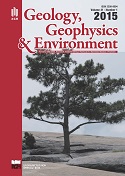New Species of Anaplecta BURMEISTER, 1838 (Blattaria) from Chiapas Amber, Mexico
DOI:
https://doi.org/10.7494/geol.2015.41.1.61Keywords:
anaplecta blattaria cockroach chiapas amber mexicoDownloads
References
Brongniart C., 1885. Les Insectes fossiles des terrains primaires. Coup d’oeil rapide sur la faune entomologique des terrains paleozoďques avec 5 planches en heliogravure. Bull. Soc. Amis Sci. Nat. Rouen 3, 21, 50–68.
Solórzano-Kraemer M.M.S. 2007. Systematic, palaeoecology, and palaeobiogeography of the insect fauna from Mexican amber. Paleontographica Abteilung A 282, 1-6, 1-133.
Vega F.J.T., Nyborg T., Coutino M.A., Solé J. & Hernández-Monzón O. 2009. Neogene Crustacea from southeastern Mexico. Bulletin of Mizunami Fossiil Museum 35, 51-69.
Vršanský P. 2002. Origin and Early Evolution of Mantises. AMBA projekty 6, 1, 16.
Vršanský P., Cifuentes-Ruiz P., Vidlička, Ľ., Čiampor jr F.J. & Vega, F.J. 2011. Afro-Asian cockroach from Chiapas amber and the lost Tertiary American entomofauna. Geologica Carpathica 62,5, 463-475.
Vršanský P. & Aristov D. 2014. Termites (Isoptera) from the Jurassic/Cretaceous boundary: Evidence for the longevity of their earliest genera. European Journal of Entomology 111, 1, 137-141.
Vršanský P. & Labandeira C., 2015. Early-derived Eocene Cockroaches (Blattaria: Ectobiidae: Pseudophyllodromiinae, Blattelinae) from the Green River Formation, Colorado, U.S.A. Proceedings of the Entomological Society of Washington (In press).
Zhang Z.J., Schneider J.W. & Hong Y.Q. 2012. The most ancient roach (Blattida): A new genus and species from the earliest Late Carboniferous (Namurian) of China, with discussion on the phylomorphogeny of early blattids. Journal of Systematic Paleontology 11,1, 27-40.
Downloads
Published
Issue
Section
License
Authors have full copyright and property rights to their work. Their copyrights to store the work, duplicate it in printing (as well as in the form of a digital CD recording), to make it available in the digital form, on the Internet and putting into circulation multiplied copies of the work worldwide are unlimited.
The content of the journal is freely available according to the Creative Commons License Attribution 4.0 International (CC BY 4.0)










